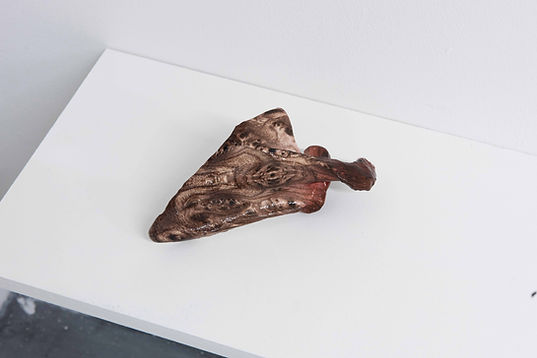razor cortex
OBJECTS
scapula/human shoulder blades, thermoplastic PVC, water transfer print, acrylic, each 19 x 10 x 7 cm
The scapula is one of the bones in the body that is one of the least likely to suffer from fractures. Thus, the manufacture of an artificial shoulder blade to replace it in case of injury would be useless from a medical point of view and would, therefore, mean an unnecessary cosmetic manipulation of the body. Such manipulation could probably be motivated by luxury and prestige reasons or the desire of becoming posthuman.

What makes the scapula appear artificial is the surface treated with the water-transfer method. The Japanese-born technique was initially developed to produce low-cost copies of precious materials such as marble, porcelain or exotic wood. In the meantime, however, the process has spread from the fake industry to the car tuning scene. It has become established as an expensive finishing technology for surfaces of everyday objects like coffee makers.
The title “Razor Cortex”, which refers to a PC performance booster, that promises a better gaming performance, is pointing on human self-optimization.
In collaboration with Félicia Eisenring, 2018/2019.





Razor Cortex at Louvre Liquidation (-90% Museum) tiny show, RETA, Zurich. Photo: Steve Laurent Graf

Razor Cortex at Louvre Liquidation (-90% Museum) tiny show, RETA, Zurich. Photo: Steve Laurent Graf

Razor Cortex at Louvre Liquidation (-90% Museum) tiny show, RETA, Zurich. Photo: Steve Laurent Graf

Razor Cortex at Louvre Liquidation (-90% Museum) tiny show, RETA, Zurich. Photo: Steve Laurent Graf







